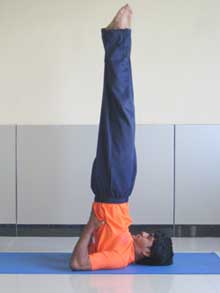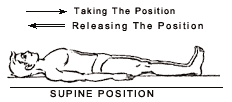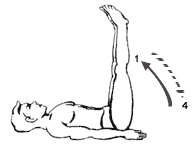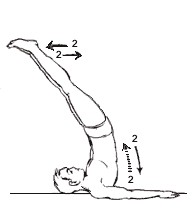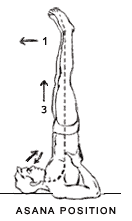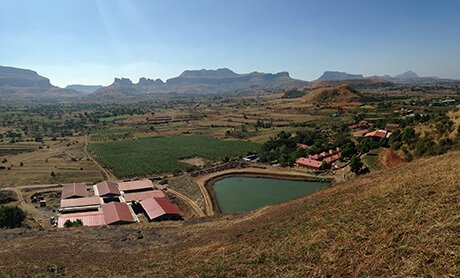Taking the asana position:
Exhale and while inhaling, contract the abdomen and slowly raise both the legs to a 90 degree angle from the floor.
Exhaling raise the waist and the hips from the floor and take the legs backwards over the head.
Inhaling raise the back and the legs up into a vertical position, placing the hands on the upper back for support. The chin should rest against the chest, creating the chin lock. Fix the eyesight on the toes and maintaining the asana, continue normal breathing.
The asana position:
One should concentrate on getting the legs, waist and the back in one straight line and making this line 90 degrees with the ground. In this asana the arms up to the elbows are placed on the floor, shoulder width apart. The body from the feet to the shoulders is in a straight line. The chest is pushed forward and the chin is placed in the throat pit / jugular notch forming a tie which is called 'Jalandhar Bandha'. All the pressure is on the neck, shoulders and the back of the head. The hands are placed on the back ribs, the legs are straight and the feet are relaxed.
Releasing the asana position:
- Inhale and while exhaling bend in the waist and lower the legs over the head, releasing the hands from the upper back.
- Inhaling slowly lower the back to the floor, keeping the legs at a 90 degree angle from the floor. Here lower the back very slowly, vertebrae by vertebrae.
- Exhaling slowly lower both legs back to the supine position.
Anatomical focus:
Neck, shoulders, abdomen
Awareness:
Keeping the body in a straight line.
Remaining balanced.
Abdominal breathing.
The focus can also be on the throat and the thyroid.
Do:
- Keep the legs straight in knees with toes pointing to the sky.
- Try and keep the body in a straight line from the chest to the tips of the toes.
- Head straight and eye sight fixed on the toes.
- Make sure that the trunk is raised enough vertically so that the chin can comfortably rest against the chest.
Don’t:
- Bend the knees.
- Move the neck or overstrain it in the chin lock position.
- Bring the legs over the head when in the asana position but don’t keep them completely vertical if it causes tension.
- Raise the head from the floor.
- Tense the legs or point the feet as this contracts the legs and prevents drainage of blood.
Benefits:
- The Jalandhar Bandha improves the function of the thyroid, parathyroid and pituitary glands due to the increase oxygen and blood. All of the other endocrine glands are regulated by the pituitary gland and so the overall function of the endocrine system is improved. This results in the improved functioning of all other systems of the body and the reduction of emotional and mental stress .
- Stagnant blood from the lower regions of the body, i.e. legs and abdomen is drained to the heart thereby improving the supply of fresh blood to these parts and the whole circulatory system. Blood supply to the head area i.e. brain, eyes, ears, nose and throat is improved thereby improving their functioning. Therefore all of the pelvic and abdominal area circulation, ear, throat and nose ailments are improved.
- The lung capacity is increased as the diaphragm, which is the muscle of respiration, has to work against gravity in this posture, this helps in the abdominal respiration and is therefore helpful in the treatment of asthma. Toxins in the respiratory system are drained thereby improving the respiratory system.
- Prevents and cures varicose veins.
- Detoxification of the body due to improved efficiency of the organs of the body which leads to youthfulness and anti-ageing effects
- Normalizes body weight due to its effect on the thyroid.
- Due to the effect this asana has on the hormonal system, particularly the thyroid, it balances the circulatory, digestive, reproductive and nervous system.
- Due to the increased blood flow to the head the mind is tranquilized, stress and psychological disturbances are removed.
- The increased blood flow can be beneficial for those who suffer from headaches, though it should not be practiced at the time of headache.
- The thymus gland is stimulated which boosts the immune system.
- It balances the parathyroid glands which ensures regeneration and normal development of the bones.
- It releases the normal gravitational pressure from the anus muscles which helps with haemorrhoids.
- The nerves passing through the neck are toned and the neck flexibility is increased.
- The digestive system is greatly improved due to the increase in blood circulation and drainage of stagnant blood.
- The pranic flow is harmonized, increasing energy and having a positive effect on all the body systems.
- Sarvangasana has all the benefits of Shirshasana but is safer and easier to perform.
Benefits for Women:
- It is beneficial for the reproductive system as there is fresh blood to the pelvic region as the stagnant blood is flushed from the organs and therefore increased efficiency of the reproductive organs.
- It strengthens the uterine ligaments as the gravity acting on the ligaments in Sarvangasan is in the opposite direction.
- It improves the functioning of the ovaries.
- It helps to balance the moods and calm the mind.
Therapeutic applications:
Thyroid disorders
Asthma
Reproductive problems
Headache
Haemorrhoids
Varicose veins
Prevention of cough and colds
Diabetes
Precautions and Contra-indications:
- Should not be performed by people suffering from high blood pressure, heart conditions or brain diseases.
- Should be avoided during menstruation and pregnancy.
- Should be avoided if suffering from a very enlarged thyroid, enlarged spleen or liver as well as cervical spondylitis, slipped disc, headache and weak blood vessels in the eyes.
Duration:
This asana is difficult in the beginning especially for women with heavy hips and men with big bellies. This asana should be maintained for 3 minutes after sufficient practice to get the desired results.
Variations and tips:
- One may need a folded blanket under the neck and shoulders for support.
- For some beginners it may be difficult to raise the legs straight. If so then one can bend the knees a little while taking the position and then straighten out the legs. Some can take help of the wall to raise the legs.
- If there is tension in the back or neck then the feet can be slightly tilted over the head like inverted pose or viparit karani.
Preparatory poses:
Dwi Pada Uttanpadasana
Viparit Karni
Follow up poses:
Matsyasana is essential to practice after Sarvangasana to counter balance the effect of the Jalandhar Bandha. Otherwise an asana that bends the head backwards like Bhujangasana or Chakrasana.
Halasan, Vistrut Pada Halasana, Karnapeedanasana and Ashwini Mudra can be practiced after Sarvangasana, before Matsyasana.
Compiled by -Jigyasu Bhaktiratna (Kate Woodworth)
